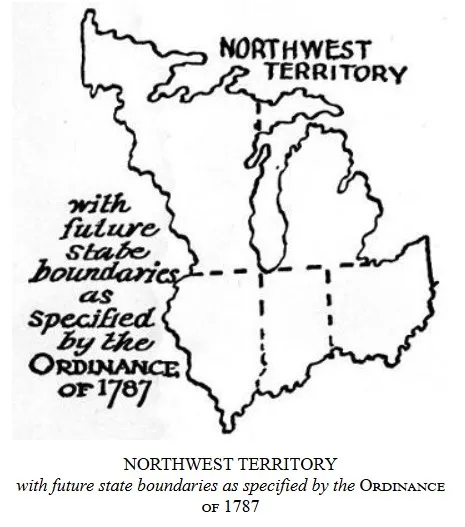Northwest Ordinance of 1787
The Northwest Ordinance—passed on July 13, 1787—was one of the most significant pieces of legislation passed by the pre-Constitution Congress. Officially called “An Ordinance for the Government of the Territory of the United States North-West of the River Ohio”, it established a framework for the governance of the Northwest Territory and laid the groundwork for westward expansion, territorial organization, and the eventual admission of new states to the country. Its provisions reflected Enlightenment ideals, addressing issues such as civil liberties, education, and the prohibition of slavery. The ordinance profoundly influenced the development of the United States, both legally and culturally.
The Northwest Territory encompassed the land northwest of the Ohio River, east of the Mississippi River, and south of the Great Lakes. This area included what are now the states of Ohio, Indiana, Illinois, Michigan, Wisconsin, and part of Minnesota. Most of this land was part of Virginia’s colonial claims. Following the American Revolution, the Treaty of Paris (1783) transferred control of this region from Great Britain to the newly independent United States. However, conflicting land claims by Virginia and other states, Native Americans’ presence and the lack of a cohesive federal policy for settlement created uncertainty and tension.
The genesis of the idea began in 1784 when Virginian Thomas Jefferson, author of the Declaration of Independence, proposed a novel plan. The states east of the Appalachian Mountains should relinquish all land claims to any territory to the west of the mountain range. This land could then be divided into new states to enter the union. Some of his ideas were a bit far-fetched; for instance, creating ten new states that were rectangular in design and even proposed the names of these prospective states. (Three years later, though, parts of Jefferson’s grand design did make it into the decrees of the Northwest Ordinance, including the gridding of townships after the land was surveyed for easier distribution among individual buyers and land companies.)
The Confederation Congress encouraged states to cede their western lands to the federal government. By 1784, most states had done so, paving the way for Congress to organize the territory. The ordinance followed earlier legislative attempts, such as the Land Ordinance of 1785, which outlined the surveying and sale of western lands. However, a more comprehensive policy was needed to address governance and the eventual transition from territories to states.

The Northwest Ordinance established a framework for the orderly settlement and political incorporation of the Northwest Territory. Its main components included how to govern the territory. The ordinance outlined a three-stage process for governing the territory. In the initial stage, Congress would appoint a governor, a secretary and three judges to administer the territory. Residents would have no elected legislature or representation in Congress. Once the population of a territory reached 5,000 free adult males, residents could elect a legislature, though the governor retained veto power. When the population reached 60,000 free inhabitants, the territory could draft a state constitution and apply for statehood. If approved, the new state would enter the Union on equal footing with the original states. This staged approach ensured a balance between federal oversight and local self-governance as the population grew.
The ordinance explicitly provided for the creation of three to five states from the Northwest Territory. It declared that these new states would enter the country as equals to the original states, ensuring a cohesive and democratic expansion process. This commitment to equality distinguished the United States’ approach to territorial growth from colonial systems elsewhere.
The Northwest Ordinance also created a territorial “bill of rights.” This guaranteed freedom of religion, the right to trial by jury, habeas corpus rights and prohibition of cruel and unusual punishment. Additionally, it included land ownership and the concept of “fee simple.” This English law stipulated that an estate in land is a form of freehold ownership that can be held without limit of time. The Northwest Ordinance was thus referred to as the “first guarantee of freedom of contract in the United States.”
The ordinance emphasized the importance of education, stating, "Religion, morality, and knowledge, being necessary to good government and the happiness of mankind, schools and the means of education shall forever be encouraged." This provision led to the allocation of land for public schools, underscoring the role of education in shaping civic responsibility and fostering prosperity. By the turn of the 19th Century, the first college Ohio University had opened and began conferring degrees.
One of the most notable provisions of the ordinance was the prohibition of slavery in the Northwest Territory. Article VI declared, “There shall be neither slavery nor involuntary servitude in the said territory, otherwise than in the punishment of crimes.” While this clause did not emancipate existing slaves in the territory or prevent the enforcement of fugitive slave laws, it established a precedent for limiting slavery’s expansion into new territories. It established a geographical boundary between free and slave regions, foreshadowing the sectional tensions that would culminate in the Civil War. With this decree, the Confederation Congress nominally set the Ohio River as the line between slave and free state in the Midwest, much as the Mason-Dixon Line became known as the de facto border in the east. The ordinance also demonstrated the federal government’s authority to regulate slavery in new territories. However, while it banned slavery in the Northwest Territory, it did not address the broader issue of slavery in the United States, leaving future conflicts unresolved.
While the Northwest Ordinance addressed settlers’ governance and rights, it largely disregarded the rights of American Indian inhabitants. The ordinance asserted that the Indian lands would not be taken without their consent, but in practice, federal policies and settler encroachment led to displacement and violent conflicts. The ordinance facilitated a westward expansion that profoundly disrupted Indian communities and set the stage for decades of conflict over land and sovereignty. Because there were no clear guidelines on how the land in the ordinance could be settled, it created a “bubbling cauldron of conflict between white settlers…and Native Americans” for the coming years. This “bubbling cauldron” erupted into warfare, including the worst defeat of American military forces in a Native American conflict in history, the Battle of the Wabash in 1791.
The Northwest Ordinance had far-reaching implications for the United States’ territorial expansion, governance, and national identity. The ordinance established a blueprint for incorporating new territories into the United States. Its structured approach to governance and statehood influenced subsequent territorial legislation, including the laws governing the Louisiana Purchase, the Mexican Cession, and the Oregon Territory.
By guaranteeing fundamental rights in the Northwest Territory, the ordinance reinforced the ideals of the Revolution and set a standard for future territories. Its emphasis on civil liberties was a precursor to the Bill of Rights in the Constitution, adopted in 1791. The ordinance’s provision for public education highlighted the federal government’s role in promoting knowledge and civic engagement. The allocation of land for schools became a cornerstone of federal land policy, influencing the establishment of public education systems across the country.
The commitment to admitting new states on equal footing ensured the United States would expand as a union of equal partners, rather than a collection of subordinate colonies. This principle of equality strengthened the federal system and fostered national unity.
The Northwest Ordinance of 1787 was the landmark achievement during the Confederation Congress, passing at the same time the Constitutional Convention deliberated in Philadelphia and drafted a new form of government. The Northwest Ordinance of 1787 provided a framework for territorial governance and statehood, rooted in the principles of equality, civil liberties, and education. While its implementation was not without shortcomings, its influence on the nation’s political and legal development cannot be overstated.
Further Reading:
- The Northwest Ordinance: Essays on Its Formulation, Provisions, and Legacy edited by Frederick D. Williams (Michigan State University Press, 1989)
- Statehood and Union: A History of the Northwest Ordinance by Peter S. Onuf (University of Norte Dame Press, 2019)




